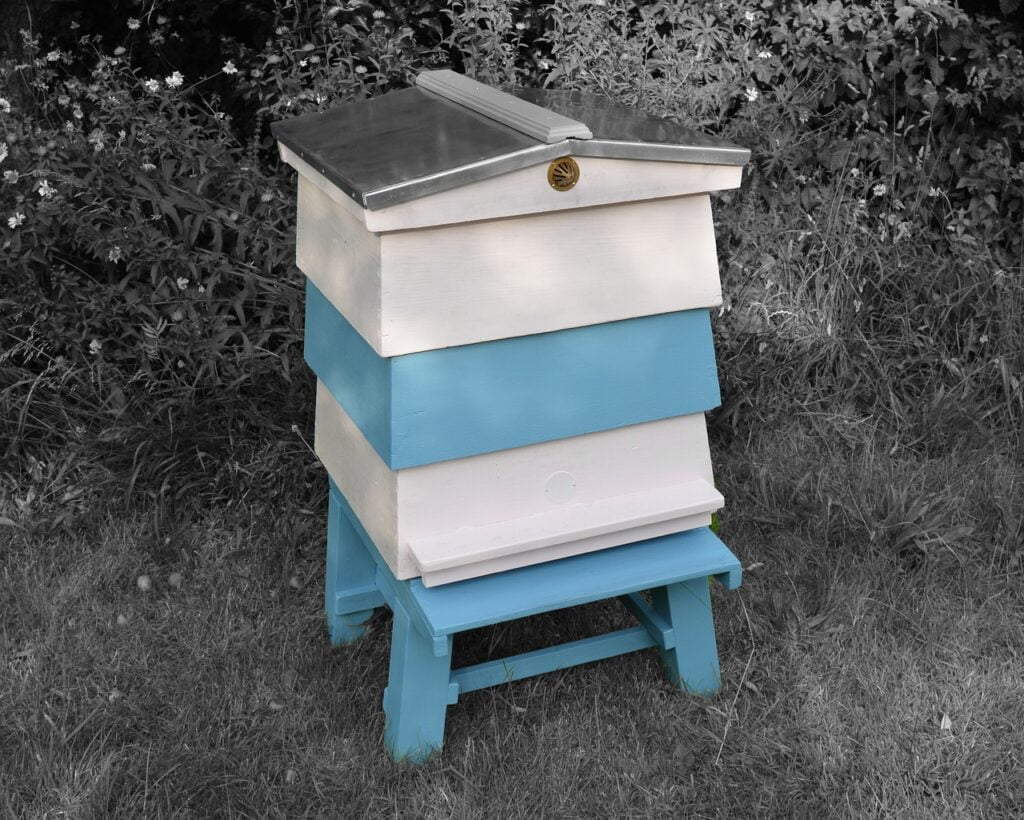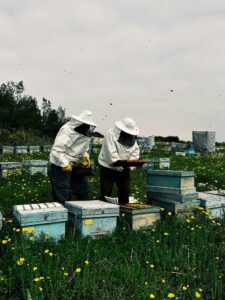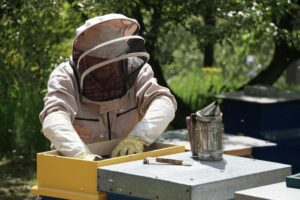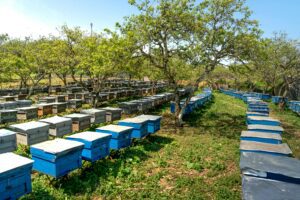The history of beekeeping is a fascinating tapestry woven over millennia, reflecting the deep and enduring relationship between humans and honeybees. From its ancient beginnings around 4,500 years ago, beekeeping has evolved dramatically, mirroring advancements in technology, agriculture, and understanding of bee biology. Early records from ancient Egypt reveal the practice’s significance, where beekeeping was not only an essential source of honey but also a symbol of prosperity and divine favor.
As civilizations advanced, so did their techniques, driven by a quest to optimize honey production and enhance hive management. This rich history showcases the ingenuity and adaptability of beekeepers through the ages, from rudimentary clay hives to sophisticated modern systems. In exploring this remarkable journey, we uncover how beekeeping has transformed from a rudimentary practice into a vital component of global agriculture and ecology.

Table of Contents
History of Beekeeping in Ancient Times
Early Beginnings: Ancient Egypt (Approximately 4,500 Years Ago)
The origins of beekeeping trace back to ancient Egypt, where evidence suggests that beekeeping practices were well established around 4,500 years ago. Egyptians were among the first to harness the benefits of honeybees, using them to produce honey and beeswax. They kept their bees in clay hives, which were likely shaped to facilitate easy management and honey extraction.
Honey was highly valued not only as a sweetener but also for its medicinal properties and its role in religious rituals. It was often used in offerings to the gods and as an embalming agent in mummification processes, reflecting its sacred and practical significance in Egyptian culture.
Greece and Rome: Evolution of Beekeeping Techniques
The Greeks and Romans built upon the foundations laid by the Egyptians, advancing beekeeping practices with their innovations and observations. In ancient Greece, beekeeping became a sophisticated and respected craft. The Greeks employed woven skeps—conical straw baskets—as well as clay hives, which were more durable and easier to manage than their predecessors.
They also began to document their beekeeping practices and theories in writing, providing a wealth of knowledge about hive management, bee behavior, and honey production.
Romans
The Romans further refined these techniques, introducing more efficient hive designs and tools. They were adept at both honey harvesting and wax extraction, which was used for a variety of purposes, including making candles and waterproofing. Roman scholars such as Virgil and Columella contributed to the body of knowledge on beekeeping, offering insights into the care of bees and the economic importance of honey production.
This period marked significant advancements in the understanding of bee behavior and hive management, setting the stage for future developments in the art and science of beekeeping.
Middle Ages
Monasteries: Beekeeping in Religious Institutions
During the Middle Ages, beekeeping found a significant and sustaining role within monastic communities across Europe. Monasteries became key centers for honey production, with monks meticulously managing beehives to produce honey and beeswax.
Honey was a valuable resource, serving not only as a primary sweetener in a time before refined sugars but also as an essential ingredient in medicinal remedies and as a component of daily nutrition.
Beeswax, on the other hand, was crucial for making candles. These candles were vital for religious ceremonies, illuminating the dimly lit spaces of churches and monasteries during services and rituals. Monastic beekeepers developed specialized techniques to extract beeswax efficiently, ensuring a steady supply for their spiritual and practical needs.
The practice of beekeeping in monasteries also had an economic dimension, as surplus honey and beeswax could be traded or sold, providing an additional source of income for these self-sustaining communities.
Europe: Expansion and Innovation
As beekeeping practices spread across Europe, they evolved significantly through the Middle Ages. The use of wooden hives became more prevalent, replacing earlier, less durable materials such as clay and straw. Wooden hives, often constructed in a more modular fashion, allowed for easier management and honey extraction.
These innovations marked a shift towards more advanced and efficient beekeeping methods, laying the groundwork for future developments in hive design.
Protective Gear
In addition to improved hive structures, the Middle Ages saw the introduction of better protective clothing for beekeepers. Early beekeeping attire, including simple veils and gloves, evolved into more comprehensive outfits designed to protect beekeepers from stings and enhance their ability to manage hives safely.
These advancements reflected a growing understanding of bee behavior and the need for effective protective measures in the practice of beekeeping.
The Middle Ages were a period of both preservation and innovation in beekeeping. Monasteries played a crucial role in maintaining and developing beekeeping practices, while broader European advancements laid the foundation for the more sophisticated techniques that would follow in later centuries.
18th and 19th Centuries
Scientific Advances: The Rise of Beekeeping Science
The 18th century marked a transformative period in the study of beekeeping, as the field began to embrace a more scientific approach. Pioneering naturalists such as Carolus Linnaeus, a Swedish botanist and zoologist, made significant contributions to the understanding of bee behavior and biology.
Linnaeus’s systematic classification of organisms, including bees, helped lay the groundwork for modern entomology. His work in categorizing and describing bee species provided a more structured framework for studying their complex social structures and life cycles.
During this period, other naturalists and beekeepers also began to observe and document various aspects of bee behavior with greater precision. This growing body of knowledge led to a better understanding of hive dynamics, including the roles of different types of bees—workers, drones, and queens—as well as the intricacies of their interactions within the colony.
The application of scientific methods to beekeeping not only enhanced the efficiency of honey production but also improved hive management practices, setting the stage for further advancements in the field.
Langstroth Hive: A Revolutionary Innovation

The most significant advancement in beekeeping during the 19th century came with the invention of the Langstroth hive in 1851. Lorenzo Langstroth, an American apiarist, revolutionized the practice of beekeeping with his innovative design. The Langstroth hive featured movable frames, a groundbreaking concept that allowed beekeepers to inspect and manage their hives with unprecedented ease and minimal disturbance to the bees.
Prior to Langstroth’s invention, beekeeping methods were largely rudimentary, often causing significant disruption to bee colonies during hive inspections and honey harvesting. The Langstroth hive addressed these issues by introducing frames that could be removed individually, allowing beekeepers to examine the hive’s interior, check for diseases, and harvest honey more efficiently.
This design not only reduced the harm inflicted on the bees but also facilitated better hive management, leading to increased honey production and improved colony health.
Langstroth’s hive quickly gained widespread adoption, and its principles remain fundamental to modern beekeeping practices. The introduction of this movable-frame hive marked a new era in apiculture, where scientific understanding and technological innovation combined to enhance both the productivity and sustainability of beekeeping.
20th Century
Industrialization: Advancements in Beekeeping Technology
The 20th century marked a significant turning point in the history of beekeeping with the advent of industrialization and technological advancements. One of the most notable innovations was the honey extractor, which revolutionized honey harvesting.
Prior to this invention, beekeepers had to remove honeycomb frames and extract honey manually, a labor-intensive and often disruptive process for the bees. The honey extractor, typically a centrifugal device, allowed beekeepers to extract honey from the comb without destroying it, significantly improving efficiency and reducing harm to the hive.
The industrialization of beekeeping also led to improvements in hive construction, such as the development of more durable and weather-resistant materials for hive bodies and frames. Additionally, advancements in bee disease management, including the introduction of treatments for pests like the Varroa mite, helped address significant challenges in maintaining healthy and productive colonies.
As beekeeping became more mechanized, it also saw the rise of specialized equipment and tools designed to streamline various aspects of hive management. Innovations such as electric uncapping knives and automatic feeders further enhanced the efficiency and convenience of modern beekeeping practices.
Beekeeping Associations and Literature: The Spread of Knowledge
The early 20th century also saw the formation of beekeeping associations and clubs, which played a crucial role in advancing the practice of beekeeping. Organizations such as the American Beekeeping Federation, founded in 1880, and various national and regional beekeeping associations provided a platform for beekeepers to share knowledge, discuss challenges, and promote best practices.
These associations often hosted conferences, workshops, and seminars, fostering a sense of community and collaboration among beekeepers.
Publications
The proliferation of beekeeping magazines, journals, and books further contributed to the spread of beekeeping knowledge. Publications such as “Gleanings in Bee Culture” and “American Bee Journal” offered beekeepers valuable information on the latest research, techniques, and trends in the field.
These resources became essential for both novice and experienced beekeepers, providing guidance on hive management, pest control, and honey production.
The 20th century’s focus on education and the exchange of information helped to standardize practices, improve hive management, and address common challenges faced by beekeepers. This era of industrialization and increased communication marked a period of rapid advancement in beekeeping, setting the stage for continued innovation and growth in the practice.
Modern Day
Technological Advances: Revolutionizing Beekeeping Practices
In the modern era, beekeeping has undergone a remarkable transformation thanks to technological advances that enhance hive management and improve bee health. One of the most significant innovations is the development of hive monitoring systems.
These systems use advanced sensors to track crucial hive conditions such as temperature, humidity, and activity levels. By providing real-time data through mobile apps or web platforms, these technologies enable beekeepers to monitor their hives remotely. This capability allows for proactive hive management, early detection of potential health issues, and timely intervention to prevent problems before they escalate.
Hive Monitoring Systems:
- Sensors: Modern hive monitoring systems utilize sensors to continuously measure and record temperature, humidity, and hive activity. This data helps beekeepers understand the internal conditions of their hives and make informed decisions to optimize hive health and productivity.
- Real-Time Data: Mobile apps and web platforms provide real-time updates, allowing beekeepers to monitor hive conditions from anywhere. This remote access is particularly useful for managing multiple hives or for beekeepers who are not always on-site.
- Proactive Management: Early detection of issues such as temperature fluctuations or humidity imbalances enables beekeepers to take corrective actions promptly, reducing the risk of hive disease and improving overall hive performance.
Advances in Bee Breeding:
Advancements in bee breeding have focused on enhancing the resilience and productivity of bee populations. Selective breeding techniques are used to develop bees with traits such as disease resistance and increased honey production.
The incorporation of genetic markers has further refined breeding practices, enabling beekeepers to target specific desirable characteristics more effectively. Improved breeding techniques aim to strengthen bee populations against environmental stressors, contributing to healthier hives and more robust colonies. See Advanced Techniques in Apiculture: 10 Pro Tips for Beekeepers for more information on this.

Precision Beekeeping Techniques:
- GPS and GIS Technology: The use of GPS (Global Positioning System) and GIS (Geographic Information System) technology allows for precise hive placement and site selection. This ensures optimal locations for hives based on environmental factors and enhances the efficiency of pollination services.
- Drone Technology: Drones are employed for aerial surveys and hive inspections, providing a bird’s-eye view of hive conditions and surroundings. This technology helps in monitoring hive health and detecting issues that may not be visible from ground level.
- Robotics: Robotics are increasingly used for automated hive maintenance tasks, including feeding, medication administration, and even hive inspections. These advancements reduce the manual labor involved in beekeeping and improve operational efficiency.
Environmental Awareness: The Role of Beekeeping in Conservation
The importance of bees in pollination and the growing concern over declining bee populations have heightened awareness about the role of beekeeping in environmental conservation. Bees are essential for pollinating a wide range of crops, which are vital for global food production. Their role in supporting biodiversity by pollinating wild plants also underscores their importance in maintaining healthy ecosystems.
Pollination Importance:
- Crops and Food Production: Bees are crucial for the pollination of numerous crops, including fruits, vegetables, and nuts. This service directly impacts food security and agricultural productivity.
- Ecosystem Services: Beyond agricultural crops, bees contribute to the pollination of wild plants, which supports biodiversity and ecosystem health. Their decline could have cascading effects on various species and habitats.
- Global Food Security: The decline in bee populations poses a significant threat to global food security, as reduced pollination can lead to lower crop yields and increased food prices.
Rise in Hobbyist and Urban Beekeeping:
The growing interest in sustainability and local food production has led to a rise in hobbyist and urban beekeeping. Individuals are increasingly engaging in beekeeping as a hobby or as part of urban gardening initiatives. This trend reflects a broader interest in sustainable living and the desire to support local biodiversity.
Hobbyist and Urban Beekeeping:
- Community Engagement: Beekeeping workshops and clubs foster community engagement and environmental stewardship. These gatherings provide education and support for new beekeepers, promoting the benefits of beekeeping and encouraging sustainable practices.
- Small-Scale Practices: Urban beekeeping often involves small-scale practices that fit within city environments. These initiatives help support local biodiversity and provide fresh, locally sourced honey.
Interest in Sustainable Living:
The contemporary consumer preference for locally sourced and sustainable products extends to honey and other bee-related products. There is growing support for organic farming practices that benefit pollinators and advocate for policies that protect bee habitats and reduce pesticide use.
Sustainable Living:
Advocacy: Advocacy efforts focus on protecting bee habitats and promoting practices that mitigate threats to bee populations, ensuring their continued role in ecological balance and food production.
Locally Sourced Products: The demand for locally produced honey and other bee products reflects a broader trend toward supporting sustainable and ethical food production practices.
Organic Farming: Initiatives promoting organic farming practices aim to create environments that are beneficial to pollinators, reducing the impact of pesticides and supporting healthy bee populations.
Conclusion
The history of beekeeping is a fascinating journey that spans thousands of years, reflecting both the enduring significance of bees and the remarkable evolution of human practices. From the ancient Egyptians’ clay hives to the scientific breakthroughs of the 18th and 19th centuries, each era has contributed to our understanding and management of these vital insects.
The industrial advancements of the 20th century, including the invention of the honey extractor and the establishment of beekeeping associations, further refined the practice, setting the stage for modern innovations.
Today, beekeeping stands at the forefront of technological advancement and environmental awareness. Hive monitoring systems, precision beekeeping techniques, and advances in bee breeding exemplify the integration of technology in enhancing hive management and productivity. Simultaneously, the rising awareness of bees’ crucial role in pollination and the growing trend of hobbyist and urban beekeeping underscore a collective commitment to sustainability and conservation.
As we look to the future, the legacy of beekeeping’s rich history continues to inspire innovation and drive efforts to protect these indispensable pollinators. By embracing both tradition and technology, we can ensure that beekeeping remains a dynamic and integral part of our agricultural and ecological landscape, safeguarding the health of our planet and the future of food production.
Throughout its history, beekeeping has evolved from simple honey collection to a sophisticated practice that supports both agriculture and environmental health. This rich legacy continues to inspire new generations of beekeepers. The New World Encyclopedia has an excellent academic view here.



